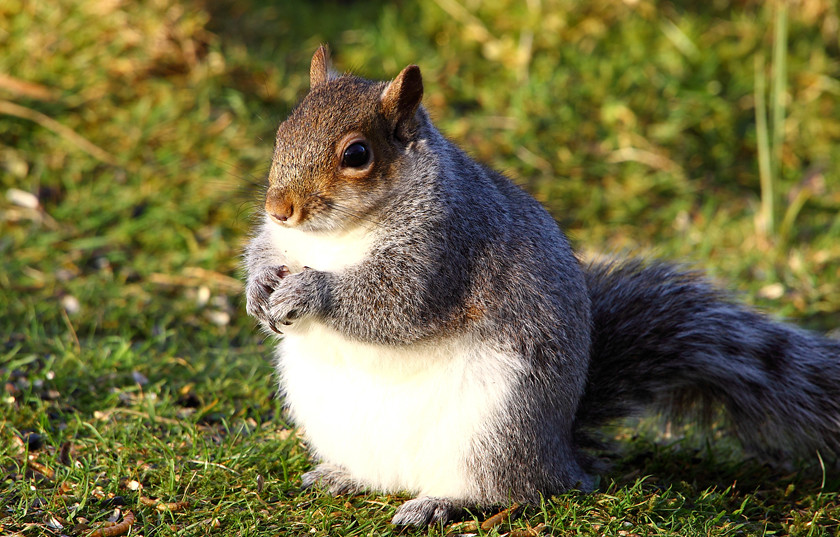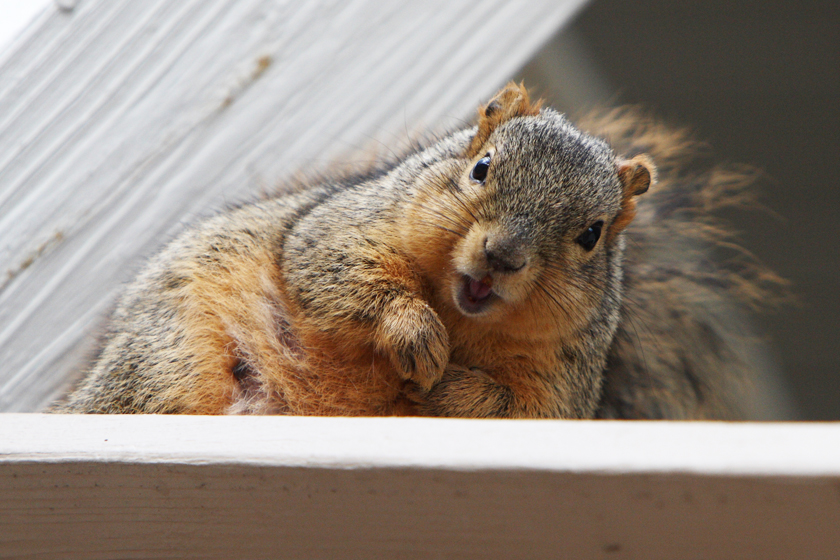Surge In Super Fat Squirrels?
Experts weigh in on why chubby wild squirrels are being spotted and photographed in several countries.
By Vicki Croke

Photo: Airwolfhound/Flickr.
They look more like fuzzy Sumo wrestlers than they do Rocky of Bullwinkle fame. And their pictures are popping up all over social media: fat squirrels.
Vicki talked to Here&Now’s Jeremy Hobson about the issue:
In the photos, we see the iconic bushy tails that curve up their backs, but the bodies look…padded. Like someone stuffed layers of foam under their little gray coats. Fat, very fat, and even sometimes obese squirrels. Showing up in online images from parts of the US, Canada, and England.
Now, a number of websites including those of the Daily Mail and even AccuWeather.com have been posting the snapshots.
The pictures are so striking that the first thing I did when I saw them was to go to the New England Wildlife Center in Weymouth, Massachusetts, to speak with Dr. Greg Mertz.
The veterinarian, who is also the head of NEWC, treats hundreds of sick, orphaned, and injured squirrels every year and has for decades. He’s a kind of squirrel savant. He went through his records to see if there was some kind of sudden uptick in squirrel weights.
Video courtesy of mstuomel/YouTube.
At the Wildlife Center, adult Eastern gray squirrels tend to weigh in at about 400 to 500 grams, that’s about the weight of a paperback book. And this year is no different.
“I look at squirrels a lot. I spend a lot of time just watching them in the wild,” Dr. Mertz says. “I’m not seeing anything that makes me think there’s an outbreak of obesity in squirrels around here. Now there are locales like college campuses, you know backyards with birdfeeders, where there are a lot of squirrels. I’ve seen the ones on Twitter, on the Internet and boy! Wow! There are some fat squirrels out there.”
So why are squirrels gaining a lot of weight in some areas and not others? Some believe that warmer weather in some spots is allowing the animals to feed more and to feed later in the season.
Dr. Mertz thinks that’s part of what might be happening—but he thinks the culprit can also be, at least in part, human-made.
He says he’s only seen chubby squirrels around places where people feed them regularly—public parks and campuses, or where they’re fed inadvertently at bird feeders.

Photo: John W. Iwanski/Flickr.
Milder winters in some places are probably extending that kind of feeding too.
Also, there are boom and bust years for oak trees and their acorn production. And acorns are important for lots of animals because they’re nice little snack packs full of protein, carbs and fats.
But is this a boom year for acorns? A BBC naturalist, Iolo Williams, is saying that it’s a “very odd, unusual year”—the acorn boom has been really fragmented and localized and he’s seen very specific spots like Cardiff in Wales with lots of acorns and fat squirrels.
“In some areas it’s been a good acorn year, which helps [squirrels] a lot, in other areas it hasn’t.
“There were a lot in Bute Park [in Cardiff]. I was in Llandovery [in Carmarthenshire] in October and there were a lot of acorns on four or five trees but very little on others, so it’s quite localised.”
“Squirrels will eat anything, they are omnivores, so I would imagine grey squirrels unfortunately will do very well this winter.”
And acorn burying is more complicated than you’d think. Squirrels practice “scatter hoarding” and because of differences in the characteristics of various acorns, some kinds get eaten nearly right away, others are saved for later, and, of course,… some are just lost.
We don’t think of most wild animals getting fat—but, in fact, they can. Animals who hibernate or slow way down for winter will actively prepare for that time by bulking up in summer and fall. Bears are particularly good at it. Grizzly bears can double their weight, for instance.
But two particular stories of extreme weight fluctuation from the animal world come to mind.

Photo: Shane Gorski/Flickr.
One was a male elephant in a zoo, described by expert Katy Payne in her book “Silent Thunder.” The bull was in musth –that’s a regular hormonal cycle that generally makes male elephants want to fight and mate—but he was in it for an extra long time. Tanked up on testosterone and agitated, he often refused to eat, and he lost more than a thousand pounds in just six months.
The other story, from the book “Polar Bears,” by biologist Ian Stirling, is of a female polar bear who lost and regained 779 pounds within eight months. She went from “a bag of bones,” as he says, of 213 pounds to a robust 992.
Let’s see a squirrel try that.

11 Responses to “Surge In Super Fat Squirrels?”
Maybe the warm weather has people outside seeing fat squirrels when we would normally be tucked away to not observe them. Or maybe our backyard feeders are staying more full because it’s still comfortable to refill it?
Clearly, the author has never seen the morbidly obese squirrels at the Pebble Beach Golf Course in California. They’ve been fat there for decades.
Just for the record, the comment about Rocky at the beginning has nothing to do with these squirrels. He was a flying squirrel and they are tiny.
fat squirrel or puffed up fur for the winter….snce they need to pack on weight during the winter slumber squirrels must be hard wired to eat as much as possible to get through the winter months. they are responding to the amount of food out there.
First it’s fat squirrels, next it’s a turkey roaming around Harvard Square! Buckle you seat belts people, this is getting weird!
It also seems likely that people can more easily take pictures of super-fact squirrels since everyone has a camera on their smartphone now, and then they can share the pictures online. It’s not interesting to take or share a picture of “normal” squirrels.
Good point! Phone cams are changing a lot of things these days — law enforcement accountability, for example! — funny to think that fat squirrel photos are on the list, maybe the most innocuous effect of the technology. I guess everything’s got a lighter side somewhere. :)
People feed the squirrels in the Boston Public Garden to the point where they’re the size of chinchillas every winter. But squirrels of course have used their adaptive intelligence here to figure out how to get food from people: If a human even pauses in walking over there, the squirrels run over, stand at their feet and of course look cute, and will even jump on people’s legs to try to get food. (Remember the far Side cartoon about the squirrel pep talk in the city park? “And Carl, put out that cigarette.”) The red tail hawks that patrol this park in spring/summer are maybe hunting elsewhere now, as the squirrels seem unafraid. Which makes me wonder, speaking of these hawks’ favorite prey: Do urban squirrel weights measure comparably with those of urban rats?
I have noticed more chubby squirrels this year. I assumed that they were fattening up for a winter that was taking its time to arrive. When it’s in the 60s on Christmas, the weather must be messing with hibernation schedules!
National Parks – chubby squirrels from folks who feed them while sitting next to signs saying, “Don’t feed the squirrels!”
cute
Comments are closed.